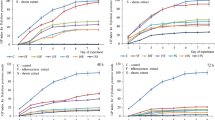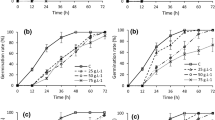Abstract
Several experiments were carried out to confirm the allelopathic potential ofAmbrosia cumanensis H.B.K. (Compositae) in a tropical zone of Mexico. The aqueous extracts of leaves and roots inhibited growth of several species used in bioassays. The wash-water of the leaves inhibited some species and stimulated others. The aqueous solutions of soil, in reference to those collected in July, were significant in their general inhibitory action. Decomposition of leaves and roots, in pots where several species were growing, was highly inhibitory to some of the seedlings; microorganisms have a major role in this process.
Similar content being viewed by others
References
Anaya, A.L. 1976. Estudio sobre el potential alelopático de algunas plantas secundarias de una zona cálido-húmeda de Mexico. Doctoral thesis, Fac. Ciencias, UNAM. 296 pp.
Amo, S.del, andAnaya, A.L. 1971. Inhibición del crecimiento producida por el géneroAmbrosia. Resúmenes del IV Simposio Latinoamericano de Fisiol.Vegetal:67.
Amo, S. del, andGómez-Pompa, A. 1976. Variability in one species ofAmbrosia (Compositae).Syst. Bot. 1:363–372.
Anaya, A.L., andRovalo, M. 1976. Alelopatía en plantas superiores; diferencias entre el efecto de la presión osmótica y los alelopáticos sobre la germinación y crecimiento de algunas especies de la vegetación secundaria de una zona cálido-húmeda de México, 676 pp.in A. Gómez-Pompa, C. Vázquez-Yanes, S. del Amo, and A. Butanda (eds.).Regneración de Selvas, Co. Ed. Continental, S. A. México.
Bonner, J., andGalston, A.W. 1944. Toxic substances from the culture media of guayule which may inhibit growth.Bot. Gaz. 106:185–198.
Curtis, J.T., andCottam, G. 1950. Antibiotic and autotoxic effects in prairie sunflower.Bull. Torrey Bot. Club 77:187–191.
Funke, G.L. 1943. The influence ofArtemisia absinthium on neighbouring plants.Blumea 5(2):281–422.
Jackson, J.R., andWillemsen, W. 1976. Allelopathy in the first stages of secondary succession on the Piedmont of New Jersey.Am. J. Bot. 63(7):1015–1023.
Kozel, P.C., andTukey, H.B., Jr. 1968. Loss of gibberellins by leaching from stems and foliage ofChrysanthemum morifolium. Princess Anne.Am. J. Bot. 55:1184–1189.
Neill, R.L., andRice, E.L. 1971. Possible role ofAmbrosia psilostachya on patterning and succession in old-fields.Am. Midl. Nat. 86:344–357.
Raynal, D.J., andBazzaz, F.A. 1975. Interference of winter annuals withAmbrosia artemisiifolia in early successional fields.Ecology 56:35–49.
Rice, E.L. 1965. Inhibition of nitrogen fixing and nitrifying bacteria by seed plants. IV The inhibitors produced byAmbrosia elatior L. andA. psilostachya D.C.Southwest.Nat. 10:248–255.
Rice, E.L. 1968. Inhibition of nodulation of inoculated legumes by pioneer plants species from abandoned fields.Bull. Torrey Bot. Club 95(4):346–358.
Wilson, R.E., andRice, E.L. 1968. Allelopathy as expressed byHelianthus annuus and its role in old field succession.Bull. Torrey Bot. Club 95:432–448.
Author information
Authors and Affiliations
Rights and permissions
About this article
Cite this article
Anaya, A.L., Del Amo, S. Allelopathic potential ofAmbrosia cumanensis H.B.K. (Compositae) in a tropical zone of Mexico. J Chem Ecol 4, 289–304 (1978). https://doi.org/10.1007/BF00989338
Received:
Revised:
Issue Date:
DOI: https://doi.org/10.1007/BF00989338




